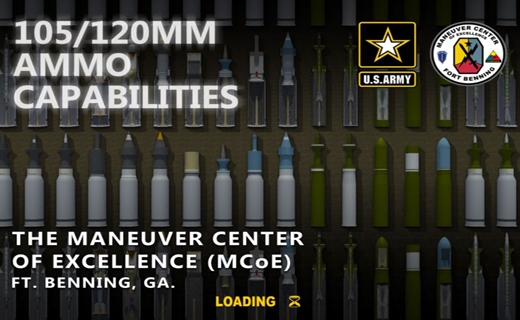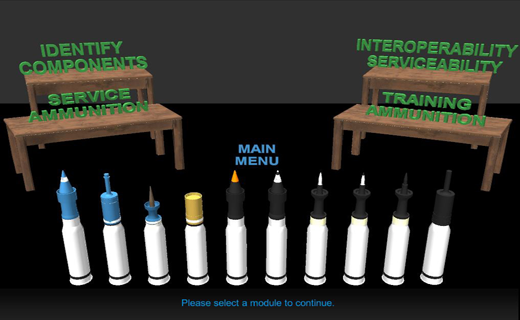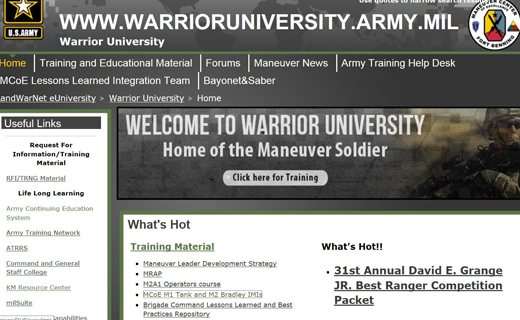From the Boresight Line: How Interactive Multimedia Instruction Can Work for You



One of the commander’s enablers is the Instructional Technology Development Team (ITDT) at the Maneuver Center of Excellence (MCoE), Fort Benning, GA.
The ITDT’s purpose is to develop digital-learning content (DLC) that can support the three learning domains (institutional, operational and self-development). This can be done by developing digital-training applications that can be implemented through commercial mobile devices supporting the Department of Defense’s “Bring Your Own Device” strategy. The ITDT is able to produce mobile applications, interactive multimedia instruction (IMI), training videos, Virtual Battlespace 2/3 scenarios and three-dimensional interactive models that can be used by students or the instructor in or out of the classroom. The products may be implemented on unit kiosks, SmartBoards or other computerized means to support the Army Learning Model (ALM).
IMI development: ammo IMI
The ITDT recently completed a 105mm / 120mm ammunition IMI for the Armor School, specifically the Department of Direct Precision Fires (Abrams Branch). The IMI was designed as a passive-learner activity to support a blended learning program for the Master Gunner Course. The ammo IMI provides instructors and students with an informative “hands-on” interactive 3D instructional training support tool that illustrates an in-depth description of individual component locations, function and characteristics for ammunition used on the M1 Abrams and Mobile Gun System Stryker vehicle.
The ammo IMI can be used to enhance the instructor’s platform-teaching techniques or be downloaded by the master-gunner student as a study aid. For anyone who has been through the Master Gunner Course, gone will be the stack of index study cards used to memorize the parts of the M829A1 Armor-Piercing Fin-Stabilized Discarding Sabot with Tracer and the many other rounds; with a simple download, the student can have the information on his desktop. Students may use the IMI in their study groups to review the content and prepare for the exam. As graduates of the course, they can then take the IMI back to home-station in their “toolbox” and easily explain the components, functionality and characteristics for main-gun ammo to peers and subordinates. The ammo IMI can also be used as a read-ahead for master-gunner candidates and in Excellence in Armor programs.
The ammo IMI also features ammo identification, which takes the user through the process of breaking down the lot number and national stock numbers by its digits; ammo planning, handling and classification are also covered. There is a section on depleted-uranium awareness and how to identify restricted and suspended munitions.
Did I mention the cool videos? There are videos of discarding sabot petals, multipurpose anti-tank and canister-round effects, and flareback.
How was this product conceived? The process begins with the unit identifying a need for digital content. The ammo IMI will be used as the example. Every year the ITDT’s chief sends requests for DLC requirements (gaming, mobile applications, digital content) to brigade S-3s for the upcoming fiscal year. A unit in our ammo example, 316th Calvary Brigade, identified a need for DLC to enhance the platform instruction of its ammunition class for master-gunner students. The brigade contacted the ITDT with a “request for instructional-training development,” which provided the name of the course, requested product, description of the product, training material associated with the request (lesson plans, PowerPoint presentations, practical exercises, etc.) and the requestor’s information. ITDT representatives meet with the requesting brigade to determine and finalize the product requirements: level of interactivity of the product, deliverables and funding.
Once the green light is given for development, the unit provides government-furnished information (GFI) to the development team. The section of the ITDT that does the DLC’s modeling and programming consists of instructional-systems designers (ISD), software developers and graphic designers / media developers, who are currently contracted to Eagle Systems and CACI.
ISDs take the supplied GFI and product description and create a “storyboard” that shows the flow of the finished product and all interactions in a PowerPoint format. Once approved by the requestor, the storyboard serves as the basis for the development, and content can no longer be added.
The storyboard is sent to the graphic designers and media developers, who will construct models and animations to fulfill the storyboard and product request. The models, animations and graphics are forwarded to the software developers, who will program and package the product for its initial delivery to the requestor. The requestor has a 10-day review period to check the product for accuracy of content and functionally. If changes are needed, they are applied and sent back to the customer for final review, and the ITDT has it posted to Warrior University for download.
Contacting ITDT
The example given is, of course, a simplified one; the actual ammo IMI took 14 months from concept to finished product, but it is well worth the wait. The IMI can be easily accessed by Army Knowledge On-line (AKO) users or Common Access Card holders by visiting (make sure you are logged into AKO first) Warrior University’s homepage. Once on the homepage, look under “What’s Hot”; click on “MCoE M1 Tank and M2 Bradley IMIs.” There are currently 12 IMIs for download; check them out and feel free to contact the ITDT with comments or suggestions.
While you are on Warrior University, check out all our products by clicking the “MCoE DoTD Training Materials” link located on the homepage under “What’s Hot.”
Want your own DLC developed? Commanders seeking development of DLC to support ALM should contact the ITDT in McGinnis-Wickham Hall, Fort Benning. Point-of-contact for product development is Dr. Roy Elam, chief of ITDT, 1 Karker St, McGinnis-Wickham Hall, Room W-121; roy.w.elam.civ@mail.mil; (706) 545-8828.
 email
email print
print